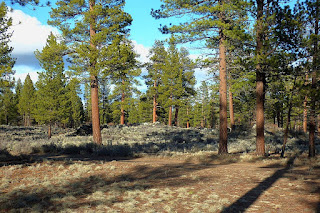C1684
“Ponderosa
Evening”
(Oregon High Desert)
Oil on Pannelli Telati Canvas Panel
9” x 12”
The
4th of July was a quite magical day for me, perched as I was, high
on the slopes of a mountainside south of Lake Timothy, Oregon Cascades, at
4400’ above sea level, and not a soul to disturb me the entire four days I was
there. What made it magical was, that instead of fireworks, I had butterflies …
all day … dozens of them flitting all about, and through my car, from one open
door and out another, and setting about upon the car itself, sometimes a dozen,
or more, on my door frame. Pure
magic! And they were there the following
two days as well, as soon as the Sun warmed them enough to come out from
wherever they spent their nights … no doubt in some salubrious Butterfly Pub
hidden from human eyes within the forest deeps. One even peed on me! I never
knew they did that, having never witnessed that before. But as one was sitting
on my sun visor, I happened to see it vibrate a bit and exude a fine spray of
droplets onto my knee below. It soon evaporated to nothing. Not gross … a
butterfly peeing on me is really the least of my worries. They seem to be
mostly a type of Tortoiseshell and a few Painted Ladies … and there were
Hummingbirds too!
There
is less wildlife in evidence here in the deep forests of the Cascades,
comparatively speaking to that which I observed out on the edge of the
Ponderosa Pine Forests of the High Desert … I was out there again at the end of
May and the first three weeks of June. One of the new dispersed campsites I found
had as many as six or eight chipmunks in view at any one time, on occasion. Of
course upon observing them with my book of North American Mammals in hand, I
discovered that they were not all chipmunks. Some were Golden Mantled Ground
Squirrels, which resemble a larger chipmunk, but have only two dark stripes on
its back. There was also another plainer
ground squirrel, I did not identify. But the last few days there was only one
chipmunk at a time, perhaps the same one, and a pair of Douglas Squirrels. A
few Chickadees, a Raven and a couple of other birds (Varied Thrushes I think),
were all I saw, again unlike out in the Ponderosas where I spotted many new
ones, and there was always something flitting about. But it was good to be up
there, these recent days, with the Rhododendrons in their prime as well as the
Beargrass. In May out in the High Desert, the sagebrush was in its lovely
silvery, with a hint of yellow, Spring greens, and the Antelope Bitterbrush (a
type of Cliff Rose), was in bloom, as though a mist of Primrose Yellow coated
the landscape (European Primroses, as I am not really familiar with the North
American kind).
 |
| Beargrass |
 |
| Close up |
 |
| Edge of the Clearing where I was camped. |
 |
| Antelope Bitterbrush |
 |
| Closer ... |
 |
| ... Closer Still. |
Pigments used in the painting:
Imprimatura: Rublev Italian Burnt
Sienna;
Drawing: Rublev Italian Burnt
Sienna;
Pigments: W&N Cobalt and
Ultramarine Deep Blues, Cadmiums Orange & Yellow Pale;
Rublev: Blue Ridge Yellow Ochre,
French Red Ochre, Italian Burnt Sienna, Lead White #1;
Schmincke: Caput Mortuum;
M. Graham: Cobalt Teal;






















